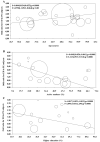Erectile dysfunction and premature ejaculation: a continuum movens supporting couple sexual dysfunction
- PMID: 35503598
- PMCID: PMC9063256
- DOI: 10.1007/s40618-022-01793-8
Erectile dysfunction and premature ejaculation: a continuum movens supporting couple sexual dysfunction
Abstract
Purpose: The specific underlying mechanisms supporting the association between erectile dysfunction (ED) and premature ejaculation (PE) are still not completely clarified. To summarize and discuss all available data supporting the relationship between PE and ED.
Methods: A comprehensive narrative review was performed. In addition, to better clarify the specific factors underlining ED and PE, a meta-analytic approach of the selected evidence was also performed. In particular, the meta-analytic method was selected in order to minimize possible sources of bias derived from a personal interpretation of the data.
Results: Current data confirm the close association between ED and PE and the bidirectional nature of their relationship. In particular, PE was associated with a fourfold increased risk of ED independently of the definition used. In addition, the risk increased in older patients and in those with lower education, and it was associated with higher anxiety and depressive symptoms. Conversely, ED-related PE was characterized by lower associations with organic parameters such as diabetes mellitus, arterial hypertension, dyslipidemia and with smoking habit. Finally, when ED was defined according to the International Index of Erectile Function questionnaire, the presence of a stable relationship increased the risk.
Conclusions: ED and PE should be considered in a dimensional prospective way considering the possibility that both clinical entities can overlap and influence each. Correctly recognizing the underlying factors and sexual complaint can help the clinician in deciding the more appropriate diagnostic and therapeutic work-up.
Keywords: Couple; Erectile dysfunction; PDE5i; Premature ejaculation; Sexual desire.
© 2022. The Author(s), under exclusive licence to Italian Society of Endocrinology (SIE).
Conflict of interest statement
The authors have no competing interests to declare that are relevant to the content of this article.
Figures







Similar articles
-
Opinions, Attitudes, and Perceptions in Relation to Erectile Dysfunction and Premature Ejaculation in the Undiagnosed Spanish Male Population. Results of the PANDORA Project.J Sex Med. 2020 Aug;17(8):1495-1508. doi: 10.1016/j.jsxm.2020.04.381. Epub 2020 Jul 1. J Sex Med. 2020. PMID: 32622766
-
Erectile dysfunction and premature ejaculation in men who have sex with men.J Sex Med. 2012 Feb;9(2):576-84. doi: 10.1111/j.1743-6109.2011.02585.x. Epub 2012 Jan 3. J Sex Med. 2012. PMID: 22214402 Free PMC article.
-
Premature Ejaculation and Erectile Dysfunction in Iranian Prostate Cancer Patients.Asian Pac J Cancer Prev. 2016;17(4):1961-6. doi: 10.7314/apjcp.2016.17.4.1961. Asian Pac J Cancer Prev. 2016. PMID: 27221881
-
Erectile Dysfunction and Premature Ejaculation in Homosexual and Heterosexual Men: A Systematic Review and Meta-Analysis of Comparative Studies.J Sex Med. 2019 May;16(5):624-632. doi: 10.1016/j.jsxm.2019.02.014. Epub 2019 Mar 26. J Sex Med. 2019. PMID: 30926517
-
The pathophysiology of acquired premature ejaculation.Transl Androl Urol. 2016 Aug;5(4):434-49. doi: 10.21037/tau.2016.07.06. Transl Androl Urol. 2016. PMID: 27652216 Free PMC article. Review.
Cited by
-
The Italian Society of Andrology and Sexual Medicine (SIAMS), along with ten other Italian Scientific Societies, guidelines on the diagnosis and management of erectile dysfunction.J Endocrinol Invest. 2023 Jun;46(6):1241-1274. doi: 10.1007/s40618-023-02015-5. Epub 2023 Jan 25. J Endocrinol Invest. 2023. PMID: 36698034 Free PMC article.
-
Associations between self-reports of physical activity, interoceptive awareness, autonomic regulation, premature ejaculation, and erectile dysfunction in Chinese men.Int J Impot Res. 2025 Apr 19. doi: 10.1038/s41443-025-01072-z. Online ahead of print. Int J Impot Res. 2025. PMID: 40251377
-
Premature ejaculation among Chinese urban men: prevalence and correlates.Sex Med. 2023 Jan 12;11(1):qfac015. doi: 10.1093/sexmed/qfac015. eCollection 2023 Feb. Sex Med. 2023. PMID: 37007854 Free PMC article.
-
Review of Mendelian randomization studies on common male-specific diseases.Front Endocrinol (Lausanne). 2025 May 16;16:1541744. doi: 10.3389/fendo.2025.1541744. eCollection 2025. Front Endocrinol (Lausanne). 2025. PMID: 40453586 Free PMC article.
-
The association between shift work, shift work sleep disorders and premature ejaculation in male workers.BMC Public Health. 2024 Jul 3;24(1):1772. doi: 10.1186/s12889-024-19141-1. BMC Public Health. 2024. PMID: 38961338 Free PMC article.
References
-
- McCabe MP, Sharlip ID, Lewis R, Atalla E, Balon R, Fisher AD, et al. Incidence and prevalence of sexual dysfunction in women and men: a consensus statement from the fourth international consultation on sexual medicine 2015. J Sex Med. 2016;13(2):144–152. doi: 10.1016/j.jsxm.2015.12.034. - DOI - PubMed
-
- Salonia A, Bettocchi C, Boeri L, Capogrosso P, Carvalho J, Cilesiz NC, et al. European Association of Urology Guidelines on Sexual and Reproductive Health-2021 Update: Male Sexual Dysfunction. Eur Urol. 2021. - PubMed
-
- Corona G, Rastrelli G, Bartfai G, Casanueva FF, Giwercman A, Antonio L, et al. Self-reported shorter than desired ejaculation latency and related distress-prevalence and clinical correlates: results from the European Male Ageing Study. J Sex Med. 2021;18(5):908–919. doi: 10.1016/j.jsxm.2021.01.187. - DOI - PubMed
Publication types
MeSH terms
LinkOut - more resources
Full Text Sources
Medical

